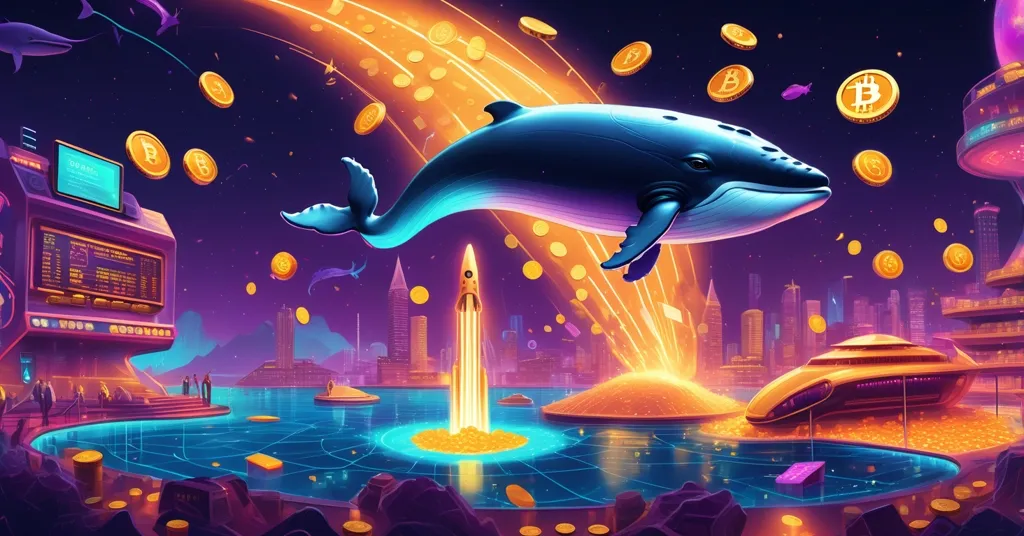Cardano Whales Buy $140M, Solana Wins Web3 Deal, BlockchainFX Hype: Crypto Update

Cardano Whales Spend Big, Solana Scores Web3 Win, BlockchainFX Sparks Hype: Crypto Market Update
The crypto market is heating up with major moves across the altcoin spectrum. Cardano (ADA) whales are splashing over $140 million in a buying spree, Solana (SOL) secures a game-changing migration from a fantasy sports giant, and BlockchainFX ($BFX) emerges as a speculative contender with promises of massive returns. Let’s break down these developments with a sharp eye on the potential and the pitfalls, championing the disruptive power of decentralization while calling out the nonsense where we see it.
- Cardano (ADA) Whale Surge: Over 200 million ADA ($140 million) accumulated in 48 hours, hinting at bullish momentum.
- Solana (SOL) Web3 Boost: Fantasy sports platform Sorare migrates from Ethereum, reinforcing Solana’s scalability edge.
- BlockchainFX ($BFX) Buzz: A new “super app” with a 180% presale spike and lofty ROI claims raises both intrigue and red flags.
Cardano’s Whale Frenzy: Bullish Signal or False Hope?
Cardano (ADA) is grabbing headlines with a staggering display of whale activity. In just two days after a market dip, high-net-worth investors—known as whales in crypto slang for their massive holdings—snapped up over 200 million ADA tokens, valued at approximately $140 million. According to Santiment, an on-chain analytics platform that tracks blockchain data, the largest wallets holding over 1 billion ADA boosted their stash from 1.50 billion to 1.59 billion tokens. Mid-tier investors, those with 10 to 100 million ADA, also increased their collective holdings by 110 million tokens, from 13.18 billion to 13.29 billion. Even more striking is the 51% drop in selling pressure, with tokens moved to exchanges for sale plummeting from 179 million to 87 million ADA. This suggests holders are locking in, betting on a price surge rather than cashing out.
For those new to the space, Cardano is a proof-of-stake blockchain, meaning it relies on users “staking” their tokens to validate transactions rather than energy-intensive mining like Bitcoin’s proof-of-work. Its native token, ADA, is used for transactions and staking rewards, and the network aims for scalability and sustainability, often pitched as a “green” alternative. Currently, ADA trades between $0.66 and $0.70, with a key resistance level at $0.73. If it breaks through, analysts point to potential targets of $0.86, $1.01, and even $1.12. But why the sudden whale interest? Some speculate it’s tied to anticipated upgrades like Hydra, a layer-2 solution designed to process thousands of transactions per second off the main chain, potentially rivaling payment giants like Visa in speed. Others see broader market trends at play, with institutional players eyeing altcoins as Bitcoin stabilizes post-ETF approvals.
Before we get too starry-eyed, let’s play devil’s advocate. Whale accumulation doesn’t always mean a master plan—it could just as easily be a coordinated pump to inflate prices before a dump. Historically, Cardano has faced criticism for slow development despite its academic rigor. Could this buying spree signal genuine confidence, or are we watching another hype cycle ready to burst? We lean toward cautious optimism here, recognizing ADA’s potential to carve a niche in scalable, sustainable blockchain tech while keeping an eye on whether the momentum holds.
Solana’s Web3 Triumph: A Game-Changer for NFTs
Moving to Solana (SOL), this high-speed blockchain is cementing its status as a Web3 powerhouse with a major win in the gaming and NFT space. Trading at $192.89 with a market cap of $105 billion, Solana has lured Sorare, a fantasy sports platform valued at $4.3 billion with 5 million users, to migrate from Ethereum by October 2025. Sorare brings 10 sports games and a marketplace for NFT trading cards—unique digital collectibles tied to real-world athletes—representing a significant boost to Solana’s ecosystem. For the uninitiated, NFTs (non-fungible tokens) are one-of-a-kind blockchain assets, often used for digital art, collectibles, or in-game items, and Web3 refers to the next generation of internet built on decentralized tech like blockchains.
“An upgrade… Solana’s leadership in active developers, total value locked, and daily addresses makes it the most viable chain for scalable consumer applications.” — Nicolas Julia, CEO of Sorare
Julia’s praise highlights Solana’s technical edge. Known for processing up to 65,000 transactions per second (TPS) compared to Ethereum’s 15-30 TPS before recent upgrades, Solana offers lightning-fast speeds and fees often under a penny, versus Ethereum’s notorious “gas” costs that can hit double digits during peak times. Total value locked, or TVL, measures the amount of crypto staked or locked in a blockchain’s apps, and Solana’s robust figures reflect strong developer and user engagement. This makes it a darling for decentralized applications (dApps), especially in gaming and sports tokens, where it already dominates a $1.17 billion market.
That said, Solana isn’t without baggage. Network outages, like the 17-hour downtime in September 2021 due to a bot-driven transaction flood, have dented its reliability rep in the past. While uptime and efficiency have improved, it’s not bulletproof. Meanwhile, Ethereum isn’t standing still—upcoming upgrades like sharding aim to slash fees and boost speed, potentially luring projects back. We applaud Solana’s push for scalable consumer apps as a textbook case of effective accelerationism, driving tech adoption even with growing pains. It fills a niche Bitcoin doesn’t touch directly, proving altcoins can complement the king of decentralized money. But will it maintain this lead, or is this just a fleeting victory lap?
BlockchainFX: Hype Machine or Hidden Gem?
Now, let’s scrutinize the flashy newcomer, BlockchainFX ($BFX), which markets itself as a crypto “super app” blending trading across cryptocurrencies, stocks, forex, and commodities. Boasting over 10,000 active users and millions in daily trading volume, BFX offers a seductive pitch: token holders receive up to 70% of platform trading fees paid out daily in USDT, a stablecoin pegged to the U.S. dollar. Think of it as a cashback scheme where users get a slice of the house’s profits. Early adopters report daily returns of 4-7%, which translates to an eye-watering 90% annual percentage yield (APY)—a measure of yearly investment returns including compound interest. Their presale price has jumped 180% from $0.01 to $0.028, raising $9.55 million from 14,800 buyers, with a launch target of $0.05. The projections are borderline absurd: a $50,000 investment now could supposedly hit $1.78 million if BFX reaches $1, a 3,400% return.
Additional perks include bonuses for early investors, referral incentives, and competitions like a $500,000 giveaway alongside tiered memberships costing $1,000 to $5,000 for perks like trading credits and branded Visa cards. Post-launch, BFX claims listings on five centralized exchanges, with revenue forecasts soaring from $30 million in 2025 to $1.8 billion by 2030, and user growth from 220,000 to 25 million. A CertiK audit—a security check by a reputable blockchain firm—adds a veneer of legitimacy. On paper, the idea of a multi-asset platform bridging traditional finance (TradFi) and decentralized finance (DeFi) sparks intrigue. If executed, it could disrupt brokerage models by cutting out middlemen and rewarding users directly, aligning with our push for financial revolution. For deeper insights into the buzz around Cardano whale activity and Solana migrations alongside BlockchainFX hype, the broader market context is worth exploring.
But let’s cut the crap—this reeks of overblown promises straight out of the 2017 ICO bubble or 2021’s meme coin mania. A 3,400% return? That’s fantasy land, not finance. High-yield schemes in crypto have a nasty history—think BitConnect or OneCoin, where “guaranteed” returns led to billion-dollar scams and countless burned investors. BFX’s model hinges on sustained trading volume, which is far from assured in a volatile market. Listings on exchanges mean little if the token flops, and while CertiK audits are a plus, they don’t guarantee against poor execution or shady intent. Team transparency and roadmap feasibility remain question marks. We’re all for disruptive innovation, but this smells like a speculative gamble dressed as a sure bet. Proceed with extreme caution—your wallet will thank you.
Bitcoin’s Shadow: How Altcoins Fit the Puzzle
Zooming out, it’s worth grounding these altcoin developments against Bitcoin’s towering presence. As Bitcoin maximalists, we view BTC as the bedrock of decentralized money, a store of value unmatched in its security and censorship resistance. Recent corporate treasury allocations—think MicroStrategy stacking billions in BTC—and growing merchant adoption solidify its role. Yet, altcoins like Cardano and Solana aren’t just noise; they’re experimenting in spaces Bitcoin doesn’t aim to dominate. Cardano’s focus on sustainable scalability and Solana’s push for high-speed dApps address real pain points, from transaction costs to consumer app viability. They’re not replacing Bitcoin but extending the decentralized ethos into new frontiers.
BlockchainFX, meanwhile, represents the riskier edge of this experimentation. While we champion disruption, we’re wary of projects that overpromise and underdeliver, diluting trust in the broader crypto movement. Bitcoin remains the gold standard, but altcoins have a place in testing the boundaries of what decentralized tech can achieve—provided they don’t devolve into pure speculation or outright scams. This balance is key to accelerating adoption without losing sight of the core principles that got us here.
The Bigger Picture: Altcoins, Bitcoin, and the Road Ahead
Stepping back, these stories—Cardano’s whale-driven momentum, Solana’s Web3 strides, and BlockchainFX’s speculative buzz—paint a vivid picture of the altcoin landscape in Q4 2025. They showcase the diversity of innovation in crypto, from proven players tackling scalability and real-world use cases to untested ventures gambling on moonshot ideas. We’re thrilled to see decentralization push boundaries, embodying the spirit of effective accelerationism by forcing rapid tech evolution, flaws and all. Solana’s gaming wins and Cardano’s institutional interest highlight how altcoins complement Bitcoin’s dominance, filling niches that drive the broader financial revolution we advocate for.
Yet, with every leap forward comes a shadow of risk. BlockchainFX reminds us that for every genuine disruptor, there’s a potential pitfall waiting to trap the unwary. As champions of freedom, privacy, and shaking up the status quo, we’re here to cheer the bold experiments while waving the red flag on blatant overhyping. The crypto space thrives on radical ideas, but it’s not a charity—invest with skepticism, not blind faith. The road to mass adoption is paved with both brilliance and broken dreams, and we’re committed to navigating it with brutal honesty.
Key Takeaways and Questions to Ponder
- What’s behind Cardano’s (ADA) recent price momentum?
Whale accumulation of over 200 million ADA ($140 million) in just two days, paired with a 51% drop in selling pressure, signals strong confidence, potentially pushing prices toward $1.12 if resistance at $0.73 breaks. - Why is Solana (SOL) becoming a Web3 leader?
Solana’s scalability, with speeds up to 65,000 transactions per second and minimal fees, lured Sorare—a $4.3 billion fantasy sports platform with 5 million users—to migrate from Ethereum, bolstering its dominance in the $1.17 billion sports token market. - Does BlockchainFX ($BFX) deserve the excitement as an investment?
BFX’s “super app” for multi-asset trading and 70% fee redistribution offers tempting innovation, but 3,400% return projections are wildly speculative; it’s a high-risk play that demands rigorous scrutiny over blind optimism. - How do altcoins like Solana and Cardano complement Bitcoin’s role?
While Bitcoin reigns as a store of value and decentralized money, altcoins tackle specific challenges—Solana with high-speed dApps and Cardano with sustainable scalability—expanding the reach of blockchain tech into diverse use cases. - Should investors prioritize new projects or stick with established coins?
Proven altcoins like ADA and SOL offer relative stability and real-world traction, while newcomers like BFX carry outsized risk despite potential; balancing portfolios with research over hype is the smarter path.



